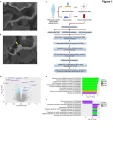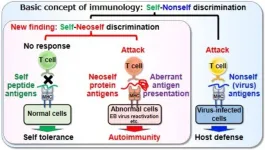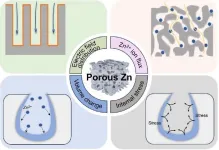(Press-News.org) Island breeze, blue lagoon, dew drop—these aren’t the names of scented candles on display at your local home goods store. They’re flavors of synthetic nicotine used in e-cigarettes, often advertised with neon-electric colors and bright lettering to make them look like boxes of candy or fruit juice. But underneath all the flair, a specific label written clearly in black text on a white background is required by law to be there: a warning that says the product contains nicotine and that nicotine is an addictive substance.
Even though health warnings need to be written on physical products sold in stores and included in traditional advertisements, a new research study led by Boston University found that the majority of ads posted on social media by synthetic nicotine brands left the warnings off.
Synthetic nicotine is a substance created in a laboratory that has the same, or very similar, chemical structure to the nicotine derived from tobacco leaves. Despite marketing that labels it as “tobacco-free nicotine,” it still has the same addictive properties and additives that can cause lung damage, cancer, and other health issues. Plus, since it’s commonly paired with appealing flavors—made from chemicals that are known to be unsafe to inhale—it can be even harder to quit.
“When synthetic nicotine started appearing in products, we really wanted to know how it was being received and how it was being promoted,” says Traci Hong, a BU College of Communication professor of media studies.
When she first started in her career as a health communication researcher, she says, it was a different era: social media was not widely used, cigarette use was declining, and electronic cigarettes and vapes were in their infancy. But when vapes containing synthetic nicotine started getting more and more popular, she turned her attention to social media to find out how the advertising of these products was being regulated—and what could be done to make them less appealing to kids and young adults.
In their new paper, Hong and her collaborators found that in over 2,000 Instagram posts from 25 different synthetic nicotine brands, the vast majority did not include warning labels informing users about the health risks. The findings have been published in JAMA Network Open.
“These are brands that I think have a legitimate responsibility to inform their potential consumers that there are health risks and you need to be aware of them,” Hong says. Especially considering that Instagram is one of the most popular social media platforms in the US for young adults.
The FDA passed a requirement in 2022 that says health warnings need to take up 20 percent of the advertising and appear in the upper portion of the advertisement for e-cigarettes that contain synthetic nicotine. Hong, who is a research fellow at BU’s Rafik B. Hariri Institute for Computing and Computational Science & Engineering, and her colleagues identified whether an image posted on Instagram included the required health warning and, if it did, whether it took up the right amount of space. The study involved interdisciplinary collaboration across the University, including experts from BU’s School of Public Health, Chobanian & Avedisian School of Medicine, and College of Arts & Sciences.
The Instagram posts were analyzed using a custom-built AI algorithm, called Warning Label Multi-Layer Image Identification (WaLi), which uses computer vision to detect if health warnings follow the FDA rules. The team found that only 13 percent of the analyzed posts complied with FDA health warning requirements. They also discovered that the posts with health warnings received fewer likes and comments than posts without the warnings. According to the paper, the larger the warning label, the less comments the posts received. This means that having health warning labels could reduce how many social media users, especially young adults, are seeing and engaging with this content.
“We need federal government policies to combat the appeal of e-cigarette advertising on social media and to prevent kids from using tobacco products,” says Jessica Fetterman, a Chobanian & Avedisian School of Medicine assistant professor of medicine and coauthor on the study. The FDA recently estimated that the number of middle and high school students using e-cigarettes in 2024 is about 1.63 million, down from 2.13 million in 2023, with the vast majority using flavored nicotine. Enforcing and requiring health warning labels on social media content is one way to make products less visible and appealing, Fetterman says.
“Our study indicates that e-cigarette brands are creating Instagram posts advertising their products with seemingly no enforcement by the social media platform or government,” Fetterman says. Instagram lists tobacco products, electronic cigarettes, “and any other products that simulate smoking” on their list of prohibited branded content. But, Fetterman says, synthetic nicotine products are flouting that rule.
“All our work is really trying to find evidence-based research to help people make informed decisions about their health,” Hong says. With synthetic nicotine and e-cigarette companies continuing to use flavors as a way to appeal to youth, she says, her team plans to monitor social media posts with WaLi to ensure brands are using the correct language to dissuade people from getting hooked.
This research was supported by the National Institutes of Health and the American Heart Association.
Republishers are kindly reminded to uphold journalistic integrity by providing proper crediting, including a direct link back to the original source URL.
END
E-cigarette brands are skirting the rules about health warning labels on Instagram
Using AI, BU researchers found that the vast majority of social media posts didn’t include health labels warning of the harms of flavored nicotine
2024-09-13
ELSE PRESS RELEASES FROM THIS DATE:
Scientists discover potential cause of an enigmatic vascular disease primarily impacting women
2024-09-13
Mount Sinai researchers have identified a key driver of a blood vessel disorder known as fibromuscular dysplasia (FMD) which affects up to five percent of the adult population and can lead to high blood pressure, heart attack, or stroke.
In a study published September 13 in Nature Cardiovascular Research, the team said changes in the gene UBR4 played an important role as a key driver of FMD. They suggested the discovery could be an important step toward developing a therapeutic approach for the disorder.
“Although fibromuscular dysplasia was first recognized more than 80 years ago, until now ...
Stimulant, antidepressant, and opioid telehealth prescription trends between 2019 and 2022
2024-09-13
About The Study: From 2019 to 2022, overall prescription volumes for stimulant and antidepressant medications increased, while prescription volume for opioids decreased. Concurrently, the proportion of telehealth prescriptions climbed across medications, increasing by a factor of 188 in opioids and more than 20 for antidepressants. These findings align with existing research highlighting the shift toward telehealth and the rise in stimulant and opioid telehealth prescribing during the pandemic. While in-person prescribing remains the most common, increasing telehealth ...
One-year weight reduction with semaglutide or liraglutide in clinical practice
2024-09-13
About The Study: In this retrospective cohort study of 3,389 patients with obesity, weight reduction at 1 year was associated with the medication’s active agent, its dosage, treatment indication, persistent medication coverage, and patient sex. Future research should focus on identifying the reasons for discontinuation of medication use and interventions aimed at improving long-term persistent coverage.
Corresponding Author: To contact the corresponding author, Hamlet Gasoyan, PhD, email gasoyah@ccf.org.
To access the embargoed study: Visit our For The Media ...
Adolescents and young adults’ sources of contraceptive information
2024-09-13
About The Study: This study’s results suggest discrepancies between preferred and actual sources of contraceptive information for assigned female at birth adolescents and young adults in the U.S. Findings underscore the role of clinicians in supporting informed contraceptive decision-making among adolescents and young adults. Clinicians were the most commonly preferred source, and receiving information from them was associated with having sufficient information to choose a contraceptive method; however, clinicians were the source with the largest discrepancy between preferred and actual use.
Corresponding Author: To contact the corresponding author, ...
Health warnings on Instagram advertisements for synthetic nicotine e-cigarettes and engagement
2024-09-13
About The Study: In this cross-sectional study of synthetic nicotine brand Instagram accounts, 87% of sampled posts did not adhere to FDA health warning requirements in tobacco promotions. Enforcement of FDA compliant health warnings on social media may reduce youth engagement with tobacco marketing.
Corresponding Author: To contact the corresponding author, Traci Hong, PhD, email tjhong@bu.edu.
To access the embargoed study: Visit our For The Media website at this link https://media.jamanetwork.com/
(doi:10.1001/jamanetworkopen.2024.34434)
Editor’s Note: Please see the article for additional information, including ...
Cleveland Clinic study identifies key factors that can impact long-term weight loss in patients with obesity who were prescribed GLP-1 RA medications
2024-09-13
UNDER EMBARGO Friday, September 13, 2024, 11 a.m. ET, CLEVELAND: A Cleveland Clinic study identified key factors that can impact the long-term weight loss of patients with obesity who were prescribed injectable semaglutide or liraglutide for the treatment of type 2 diabetes or obesity. The study was published in JAMA Network Open.
“In patients with obesity who were prescribed semaglutide or liraglutide, we found that long-term weight reduction varied significantly based on the medication’s active agent, treatment indication, dosage and persistence with the medication,” said Hamlet Gasoyan, Ph.D., lead author of the study ...
Neoself-antigens induce autoimmunity in lupus
2024-09-13
Osaka, Japan – Autoimmune diseases are widespread and notoriously difficult to treat. In part, this is because why the immune system attacks its own tissues in patients with these conditions remains poorly understood.
In a study recently published in Cell, researchers from Osaka University have revealed that the body’s own proteins with unusual structure trigger immune cells to unleash a wave of inflammation that leads to autoimmunity.
Autoimmune diseases develop when the body’s immune system mistakenly attacks its own tissues instead of fighting off foreign invaders like bacteria or viruses. However, it has long been a mystery why this happens, as ...
New therapy that targets and destroys tau tangles is a promising future Alzheimer’s disease treatment
2024-09-13
Scientists have developed new potential therapies that selectively remove aggregated tau proteins, which are associated with Alzheimer’s disease, and improve symptoms of neurodegeneration in mice.
The team of scientists, from the Medical Research Council Laboratory of Molecular Biology (MRC LMB) in Cambridge, UK, and the UK Dementia Research Institute (UK DRI) at the University of Cambridge, say this promising approach could also be applied in future to other brain disorders driven by protein aggregation inside cells, ...
Study finds ‘supercharging’ T cells with mitochondria enhances their antitumor activity
2024-09-13
Fighting cancer is exhausting for T cells. Hostile tumor microenvironments can drain their mitochondrial activity, leading to a condition known as T cell exhaustion. This phenomenon also hinders adoptive cell therapies, in which healthy, tumor-targeting T cells are infused into patients with cancer. A novel method to boost mitochondrial activity and charge up T cells is needed.
Investigators from Brigham and Women’s Hospital, a founding member of the Mass General Brigham healthcare system, in collaboration with colleagues at Leibniz Institute for Immunotherapy in Germany, have developed a way to “supercharge” T cells by supplying them with extra mitochondria ...
Harnessing the power of porosity: A new era for aqueous zinc-ion batteries and large-scale energy storage
2024-09-13
As the global demand for energy storage solutions grows, the limitations of current lithium-ion batteries, such as safety concerns and high costs, have driven the exploration of alternative technologies. Aqueous zinc-ion batteries (AZIBs) have emerged as a promising candidate due to their inherent safety, cost-effectiveness, and environmental sustainability. However, challenges like zinc dendrite growth continue to hinder their widespread adoption. Due to these challenges, there is a pressing need to delve deeper ...
LAST 30 PRESS RELEASES:
First Editorial of 2026: Resisting AI slop
Joint ground- and space-based observations reveal Saturn-mass rogue planet
Inheritable genetic variant offers protection against blood cancer risk and progression
Pigs settled Pacific islands alongside early human voyagers
A Coral reef’s daily pulse reshapes microbes in surrounding waters
EAST Tokamak experiments exceed plasma density limit, offering new approach to fusion ignition
Groundbreaking discovery reveals Africa’s oldest cremation pyre and complex ritual practices
First breathing ‘lung-on-chip’ developed using genetically identical cells
How people moved pigs across the Pacific
Interaction of climate change and human activity and its impact on plant diversity in Qinghai-Tibet plateau
From addressing uncertainty to national strategy: an interpretation of Professor Lim Siong Guan’s views
Clinical trials on AI language model use in digestive healthcare
Scientists improve robotic visual–inertial trajectory localization accuracy using cross-modal interaction and selection techniques
Correlation between cancer cachexia and immune-related adverse events in HCC
Human adipose tissue: a new source for functional organoids
Metro lines double as freight highways during off-peak hours, Beijing study shows
Biomedical functions and applications of nanomaterials in tumor diagnosis and treatment: perspectives from ophthalmic oncology
3D imaging unveils how passivation improves perovskite solar cell performance
Enriching framework Al sites in 8-membered rings of Cu-SSZ-39 zeolite to enhance low-temperature ammonia selective catalytic reduction performance
AI-powered RNA drug development: a new frontier in therapeutics
Decoupling the HOR enhancement on PtRu: Dynamically matching interfacial water to reaction coordinates
Sulfur isn’t poisonous when it synergistically acts with phosphine in olefins hydroformylation
URI researchers uncover molecular mechanisms behind speciation in corals
Chitin based carbon aerogel offers a cleaner way to store thermal energy
Tracing hidden sources of nitrate pollution in rapidly changing rural urban landscapes
Viruses on plastic pollution may quietly accelerate the spread of antibiotic resistance
Three UH Rainbow Babies & Children’s faculty elected to prestigious American Pediatric Society
Tunnel resilience models unveiled to aid post-earthquake recovery
Satellite communication systems: the future of 5G/6G connectivity
Space computing power networks: a new frontier for satellite technologies
[Press-News.org] E-cigarette brands are skirting the rules about health warning labels on InstagramUsing AI, BU researchers found that the vast majority of social media posts didn’t include health labels warning of the harms of flavored nicotine




